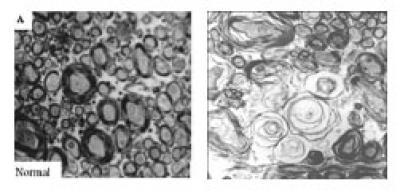Rats exposed to the antidepressant citalopram, a serotonin-selective reuptake inhibitor (SSRI), just before and after birth showed substantial brain abnormalities and behaviors, according to a new study. The long-distance connections between the two hemispheres of the brain showed stunted growth and degeneration and the animals also became excessively fearful when faced with new situations and failed to play normally with peers – behaviors reminiscent of novelty avoidance and social impairments seen in autism.
The abnormalities were more pronounced in male than female rats, just as autism affects 3-4 times more boys than girls.
Last July, a study reported an association between mothers taking antidepressants and increased autism risk in their children. It found that children of mothers who took SSRI's during the year prior to giving birth ran twice the normal risk of developing autism – with treatment during the first trimester of pregnancy showing the strongest effect. A study published last month linked the duration of a pregnant mother's exposure to SSRIs to modest lags in coordination of movement – but within the normal range – in their newborns.
Cross-sections of the part of the rat brain that connects the left and right hemisphere (corpus collosum) show stunted development of neuronal wiring, called axons, in an animal that received an antidepressant (right) during a critical period around the time of birth. A protective sheath, called myelin (visible in normal animal at left), that normally wraps the axons and boosts their efficiency, failed to develop normally in the treated animal. The resultant inefficient neuronal communications could underlie the pattern of deficits seen in autism. Credit: Rick C.S. Lin, Ph.D., University of Mississippi Medical Center
Earlier studies had hinted that serotonin plays an important role in shaping the still-forming brain in the days just after a rat is born, which corresponds to the end of the third trimester of fetal development in humans. Experimental manipulations of the chemical messenger during this period interfered with formation of sensory-processing regions of the cortex, or outer mantle, and triggered aggressive and anxiety-related behaviors in rodents.
"Our findings underscore the importance of balanced serotonin levels – not too high or low -- for proper brain maturation," explained Rick Lin, Ph.D., of the University of Mississippi Medical Center, Jackson, a Eureka Award grantee of the NIH's National Institute of Mental Health.
There is also recent evidence in humans that serotonin from the placenta helps shape development of the fetal brain early in pregnancy. Disrupted serotonin has been linked to mood and anxiety disorders. SSRIs, the mainstay medication treatment for these disorders, boost serotonin activity. ,
Lin and colleagues gave citalopram to male and female rat pups prenatally and postnatally and examined their brains and behavior as they grew up. Male, but not female, SSRI exposed rat pups abnormally froze when they heard an unfamiliar tone and balked at exploring their environment in the presence of unfamiliar objects or scents. These behaviors persisted into adulthood. The male pups especially also shunned normal juvenile play behavior – mimicking traits often seen in children
A key brain serotonin circuit, the raphe system, known to shape the developing brain during the critical period when the animals were exposed to the drug, showed dramatic reductions in density of neuronal fibers. Evidence of stunted development in the circuit coursed through much of the cortex and other regions important for thinking and emotion, such as the hippocampus.
The researchers also discovered miswiring in the structure responsible for communications between the brain's left and right hemispheres, called the corpus collosum. Extensions of neurons, called axons, through which such long-distance communications are conducted, were deformed. A protective sheath, called myelin, that normally wraps and boosts axons' efficiency-- like insulation on an electrical wire – was reduced by one-third in the treated animals. This damage was three times worse in male than in female pups and would likely result in abnormal communication between the two hemispheres, say the researchers.
Moreover, the perinatally exposed animals showed evidence of neurons firing out of sync and other electrophysiological abnormalities, suggesting faulty organization of neuronal networks in the cortex.
Published in the Proceedings of the National Academy of Sciences.




Comments